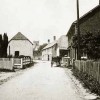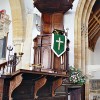A prison sentence today has been cynically likened by some people to being at Butlins when compared with the austere conditions of penal servitude in the 19th century. Assuredly, conditions were a lot harsher then, and nobody living at the time would likely have doubted that one stretch in prison was an effective deterrent against recidivism. But what would conditions have been like in the county goal at Dorchester during the period from about 1800 to 1950? What follows is an account of those conditions based on documentary research.
Dorchester’s present prison stands behind a high and thick redbrick wall just off the town’s North Square. In 1773 the penal reforms of Thomas Howard were about to change the nature of incarceration here as everywhere else. Prior to 1795 the gaol was a much smaller institution in a ruinous condition elsewhere in the town which, in 1784, prompted William Tyler of Vine Street, St. James, to draw up plans for an entirely new penitentiary for an estimated £4,000. Howard had a strong link with Dorchester, and plans were drawn up for a larger, more secure prison on the present North Square site, the building contract being secured by John Fentiman of Newton Butts for £12,000. By a contractual agreement the work was scheduled for completion in March 1792, but the building was well in arrears by December 1793. It was eventually opened for occupation by inmates in 1795.
When viewed in elevation from the front (beyond the perimeter wall) the main building comprises three elements: a central, five-storey block flanked by three-storey wings to each side. In the central block the floors are accessed via a well of alternating metal staircases. In the north block however, the stairwell is positioned at the end, while in the south block it runs up the middle. In total the prison was constructed in six blocks, the entrance block comprising the keeper’s office, brewhouse and bath-house, all within the retaining perimeter wall. This part fronted by a broad, high archway in austere Portland stone ashlars and with thick, double doors painted black, accesses three courtyards, one each for the keeper, the women felons and the women penitentiaries.
The centre block houses the keeper’s quarters, the prisoner’s visiting rooms, the debtor’s custody area and several single working cells. Above them on the first floor are the chapel, the cells for condemned and refractory prisoners, the debtors sleeping rooms and single sleeping cells. At each corner of this main block are four smaller blocks having single cells for working and sleeping. There are seven inner courtyards for separating each category of prisoner.
According to the penal system and administration of prisons at the time convicts were distinguished both by sex and as felons (those awaiting trial for either jailing or transportation.) Besides these there were other categories such as those in prison for debt, bigamy, vagrancy, idleness in domestic service or apprenticeship, for breach of contract or under the terms of a bastardy order. As far as was possible all these categories were kept apart from one another and the building had separate sleeping cells each 8’5 x 6.5 x 9 feet in size. The debtors had working cells, a day room 18 x 13.5 x 12 feet in size and slept four to a room though they were not kept in separate confinement.
It is noted that the prisoner’s daily rations of food consisted of one-and-a-half pounds of bread, though this was a day old, despite being baked in the prison itself using flour from which bran had not been extracted. Those prisoners who worked however, were entitled to an extra ration of food and from the Keeper’s account records it appears that 9d worth of meat was permitted, later increased to 2/6d worth a week. However, it is probable that this increase reflects the sharp rise in the price of bread caused by the French wars early in the 19th century rather than any increase in amount of the ration.
By 1813 the special meal that had cost 6d in 1794 had risen to 2/6d. Broth to the value of 10d was also served. Children were fed on a special diet, but prisoners were treated to a special meal at Christmas and Whitsuntide. Prisoners brought to the sessions were permitted to buy meat, fish, fruit and pastry, but following conviction only bread was allowed. Sick convicts were given food and drink of better quality, including jelly, wine and gin. In addition to a special diet when ill, prisoners were given rush-lights or candles; those “affected by itch” were given special nightshirts.
Because of sickness special measures were taken to ensure the prison was kept clean. The gaol appears to have been organised into eight wards, each of which was overseen by a warder responsible for sweeping out the cells and washing them out once a week. Several women cleaners were also paid to carry out this work. Sometimes gunpowder was used for fumigating and, once a year, parts of the building were lime-washed. Prisoners themselves were washed upon admittance and provided with clothes. Prisoners working outside the gaol were issued with “small frocks” bearing the lettering “DORSET GAOL” on the back. Women prisoners were issued with dresses, aprons, petticoats and bed gowns, while men had shoes, shirts, trousers, shifts, hose and clogs bought for them.
The cells were furnished with iron bedsteads fixed four inches from a wall and equipped with straw-filled bedding. Prisoners could be subjected to enforced discipline by means of solitary confinement in a dark cell, though the governor was under an obligation to visit such prisoners at least once a day. The Chaplain would have read prayers three times a day and distributed religious books as thought necessary. He had to visit and counsel the prisoners in private to assess their mental states and keep a log of his findings. To prevent escapes, all prisoners had their clothes confiscated each night.
Of course, until as late as 1965 when the death penalty was abolished in Britain, prison would often be just a temporary custody facility pending a time of execution to be fixed for those sentenced to death. As in other county gaols Dorchester would have had its own facilities for carrying out executions: in this case, gallows set up outside the main building. Consequently, the current “cell-block” or overcrowding crisis now facing the penal system could never have arisen over a century ago. At Dorchester those sentenced to death were kept in cells near the chapel. Early in the 18th century, long before the present prison was built executions were very public affairs in public places. Until 1766, when the gallows there were removed, hangings were routinely carried out at Maumbury Rings on the outskirts of Dorchester, that of Mary Channing in 1706 being a particularly high-profile case of the time.
But notable executions were carried out behind the present prison wall as well. Especially tragic was the highly public hanging of Elizabeth Martha Brown on August 9th, 1856, attended by a crowd of several thousand including a 16-year-old apprentice architect called Thomas Hardy. Martha had been found guilty of bludgeoning her husband to death with the kitchen wood-axe in anger upon discovering his adultery. James Seale was hanged on August 10th, 1858, for the murder of a girl called Sarah Guppy, but the last execution of all in Dorchester took place in 1887.
Today, under the prison’s present governor, Serena Watts, its operational capacity is about 260, with all males except category A being held there. There is no segregation unit. The regime includes provision of workshops, and the prison is currently running a programme of full education including courses on thinking, life and social skills and substance awareness. Strong emphasis is also placed upon physical education.
In conclusion, one interesting feature of the prison’s location is the fact that it was built where a Roman townhouse had once stood, but this was either disregarded or overlooked when the foundations were laid. It was not until the grave of Martha Brown was being dug within the prison precincts 64 years later that a floor mosaic was uncovered, though this was not lifted and removed to the County Museum until the burial of James Searle two years later re-exposed it.
Note: Fuller accounts of the Channing and Brown cases can be found on the site.
Note: The last execution to be carried out at Dorchester was on the 24th of July 1941, when David Jennings was hanged; our thanks to John Grainger for bringing this to our attention.



